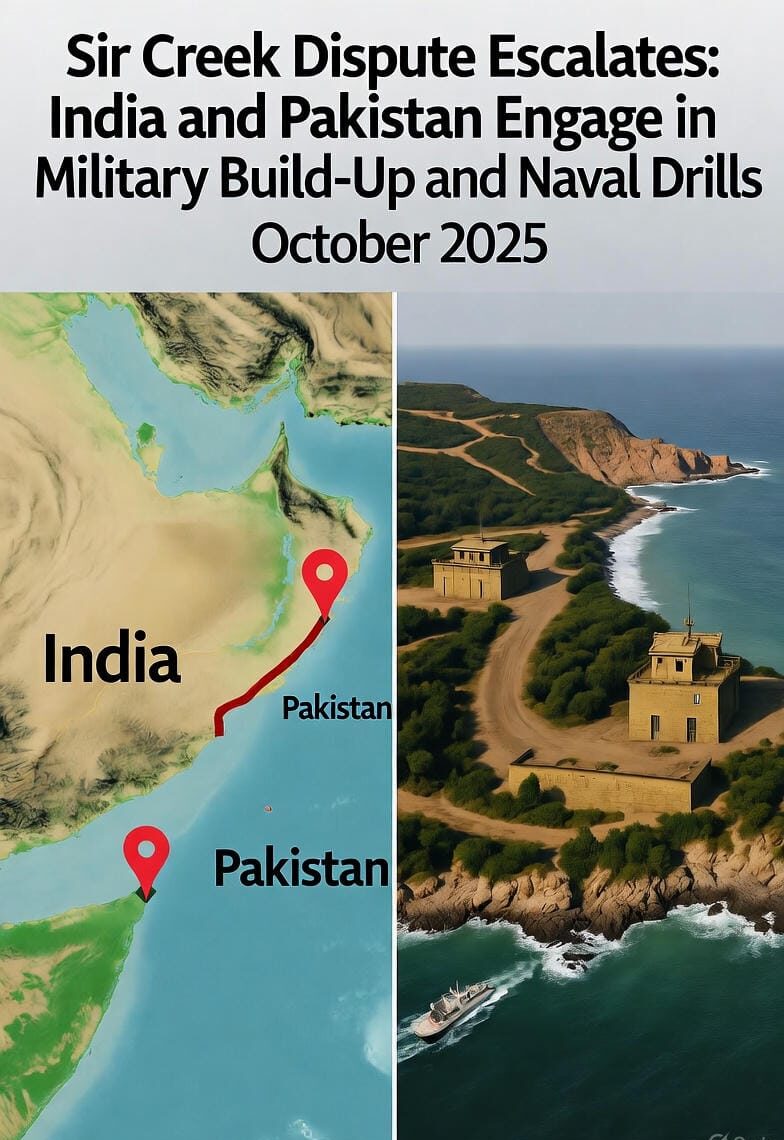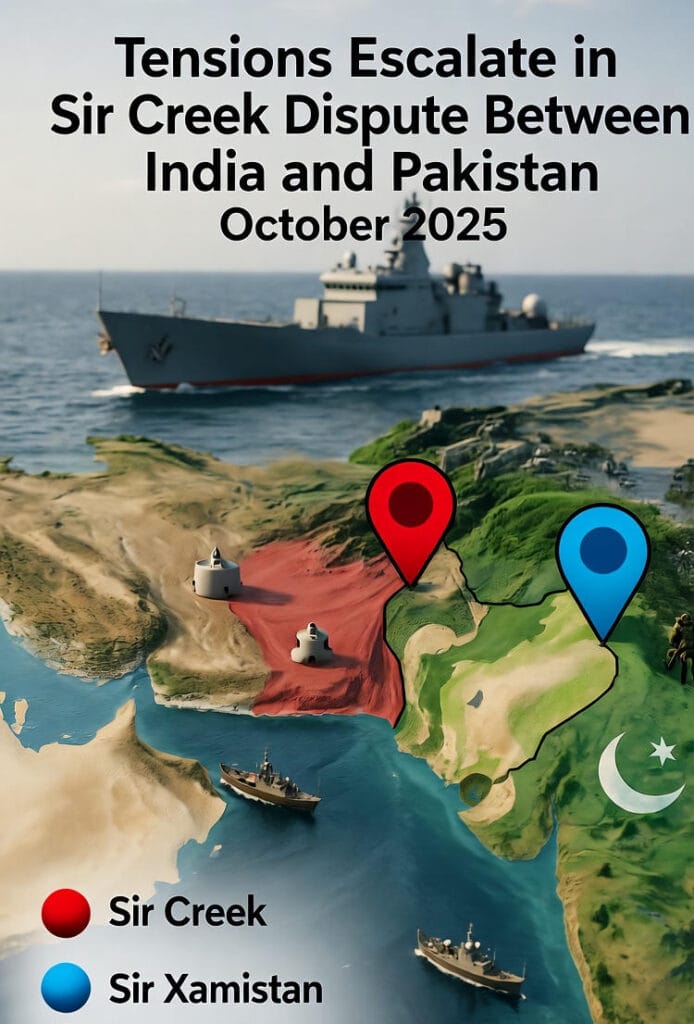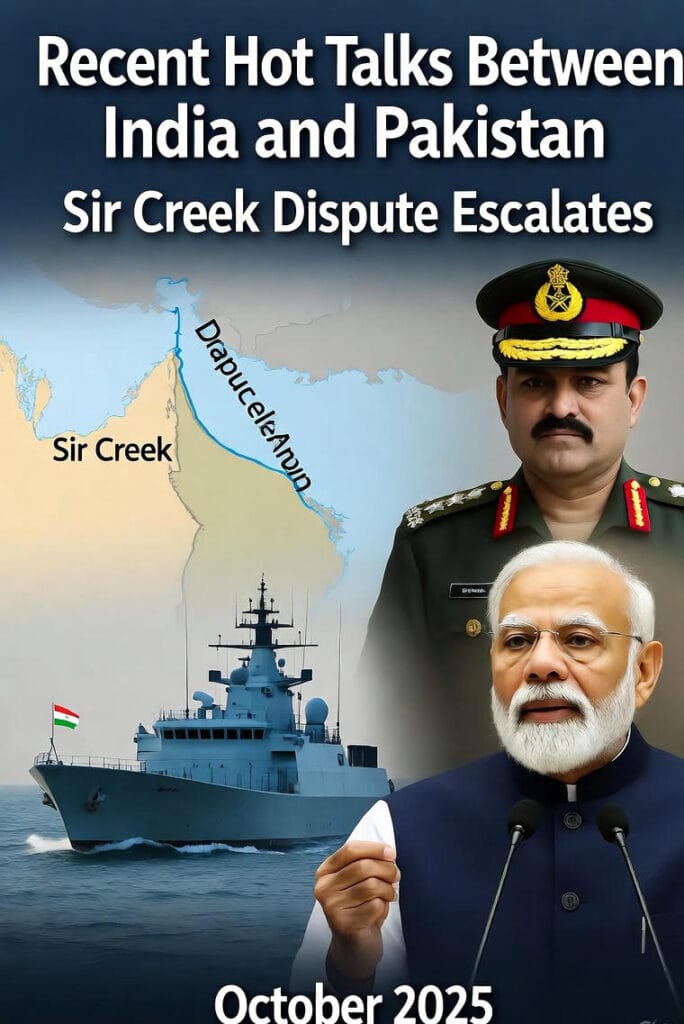
In the volatile landscape of South Asian geopolitics, the Sir Creek dispute—a longstanding territorial and maritime boundary issue between India and Pakistan—has surged to the forefront in October 2025. This 96-kilometer tidal estuary in the Rann of Kutch, straddling India’s Gujarat and Pakistan’s Sindh, is more than a muddy wetland; it’s a strategic flashpoint threatening to ignite a broader conflict. Following the brief but intense May 2025 “Operation Sindoor” clash, recent military posturing and fiery rhetoric have raised fears of war within days. This blog delves into the Sir Creek dispute’s roots, its strategic stakes, and the urgent need for de-escalation, offering insights for those tracking India-Pakistan tensions 2025.
Understanding the Sir Creek Dispute
The Sir Creek dispute, unresolved since the 1947 Partition, centers on a seemingly trivial marsh but carries profound implications for regional security, economic interests, and national pride. The disagreement hinges on where to draw the boundary line, affecting control over the creek and its adjacent Exclusive Economic Zone (EEZ) in the Arabian Sea.
Historical Roots of the Conflict
The origins trace to colonial-era ambiguities, notably a 1908 dispute over firewood rights between the princely states of Kutch and Sindh. Post-Partition, the 1965 Indo-Pakistani War saw skirmishes in the Rann of Kutch, leading to a 1968 International Tribunal Award that allocated 90% of the Rann to India but left Sir Creek undefined. Six rounds of bilateral talks (1969–2006) have failed to bridge the gap, with both nations entrenched:
- India’s Stance: Advocates a midline demarcation based on international maritime law, citing colonial maps and the 1968 tribunal. This grants India the western bank and a larger EEZ share, critical for offshore resources.
- Pakistan’s Position: Claims the entire creek to the eastern bank, referencing a 1914 agreement. This maximizes Pakistan’s EEZ, eyeing potential oil and gas reserves.
The dispute disrupts local fishermen, with over 200 Indian detentions by Pakistan in 2024 alone, fueling grassroots tensions.
Strategic and Economic Significance
Sir Creek is no mere backwater. Its resolution determines:
- Maritime Control: The EEZ at stake spans over 11,000 square kilometers, rich in hydrocarbons and fishing grounds vital to Pakistan’s energy-starved economy and India’s maritime ambitions.
- Military Leverage: The creek’s proximity to Gujarat’s ports and Pakistan’s Karachi makes it a potential staging ground for amphibious or drone operations, as seen in Pakistan’s failed May 2025 incursion attempt.
- Geopolitical Weight: China’s support via the China-Pakistan Economic Corridor (CPEC) emboldens Pakistan, while India’s strategic partnership with the U.S. adds external pressures.
Escalating Tensions in October 2025

The Sir Creek dispute has flared dramatically in recent days, driven by military build-ups and aggressive rhetoric echoing the May 2025 clash, where India’s missile strikes responded to a Pahalgam terrorist attack. Current developments suggest a dangerous trajectory.
Recent Hot Talks
High-level statements have amplified tensions, with state media on both sides fanning nationalist flames:
- India’s Warnings (October 2–3, 2025): Defence Minister Rajnath Singh, speaking in Bhuj, Gujarat, declared, “If Pakistan acts in Sir Creek, our reply will reshape history and geography.” Army Chief General Upendra Dwivedi warned of erasing Pakistan “from the map” if provocations continue, tying rhetoric to Sir Creek deployments.
- Pakistan’s Counter (October 4–5): Pakistan’s Navy announced live missile and gunnery drills near Karachi for October 9–10, signaling defiance. Foreign Minister Ishaq Dar accused India of violating the 1972 Simla Agreement, rejecting U.S. mediation linked to Trump’s Gaza peace plan.
- Social Media Surge: The hashtag #SirCreek has trended on X, with over 500,000 posts since October 1, blending outrage and misinformation. Indian accounts frame Pakistan as a “terror sponsor,” while Pakistani users decry India’s “hegemonic aggression.”
Why War Looms Within Days
The dispute’s volatility stems from compressed escalation pathways:
- Operational Risks: India’s Cold Start doctrine, enabling rapid offensives, meets Pakistan’s tactical nuclear arsenal, shrinking decision windows to 24–48 hours. A naval incident in Sir Creek could trigger automated responses, as RAND war games predict 10,000 casualties in Week 1.
- Military Build-Up: Pakistan’s deployment of Chinese-supplied HQ-9 missiles and drones near the creek alarms India, which has bolstered Jaisalmer-Gujarat sectors. Locals report heightened coastal patrols.
- Diplomatic Vacuum: Post-May 2025, U.S. mediation fatigue and Pakistan’s distrust of third-party roles (e.g., rejecting Trump’s proposals) limit de-escalation avenues.
Pathways to De-Escalation

Despite the saber-rattling, opportunities for restraint exist. A UN Security Council session on October 10 could press for renewed hotlines. Experts like Michael Kugelman advocate “narrative neutrality” to humanize adversaries.
Short-Term Confidence-Building Measures
- Maritime Ceasefire: A temporary halt to naval drills, as proposed in 2006 talks, could cool tensions.
- Fishermen Amnesty: Releasing detained fishermen would signal goodwill, addressing humanitarian concerns.
- Digital Moderation: Platforms like X could curb inflammatory posts, building on Meta’s 2024 algorithms.
Long-Term Resolution Strategies
Sustainable peace requires addressing root issues:
- Bilateral Talks: Reviving the Composite Dialogue, paused since 2003, to tackle Sir Creek alongside Kashmir.
- Joint Resource Management: Co-developing EEZ resources, modeled on India-Bangladesh maritime resolutions, could incentivize cooperation.
- International Oversight: Neutral arbitration, despite India’s objections, could clarify boundaries using modern satellite mapping.
Conclusion
The Sir Creek dispute, though geographically small, encapsulates the India-Pakistan rivalry’s volatility. As October 2025 unfolds, the October 9–10 naval drills loom as a critical test. Without diplomatic intervention, state-driven narratives risk propelling both nations toward catastrophe. Stakeholders must prioritize dialogue over provocation, drawing on frameworks like the Simla Agreement to forge lasting peace. For updates on India-Pakistan tensions 2025, explore resources from the Council on Foreign Relations or follow #SirCreek on X.





